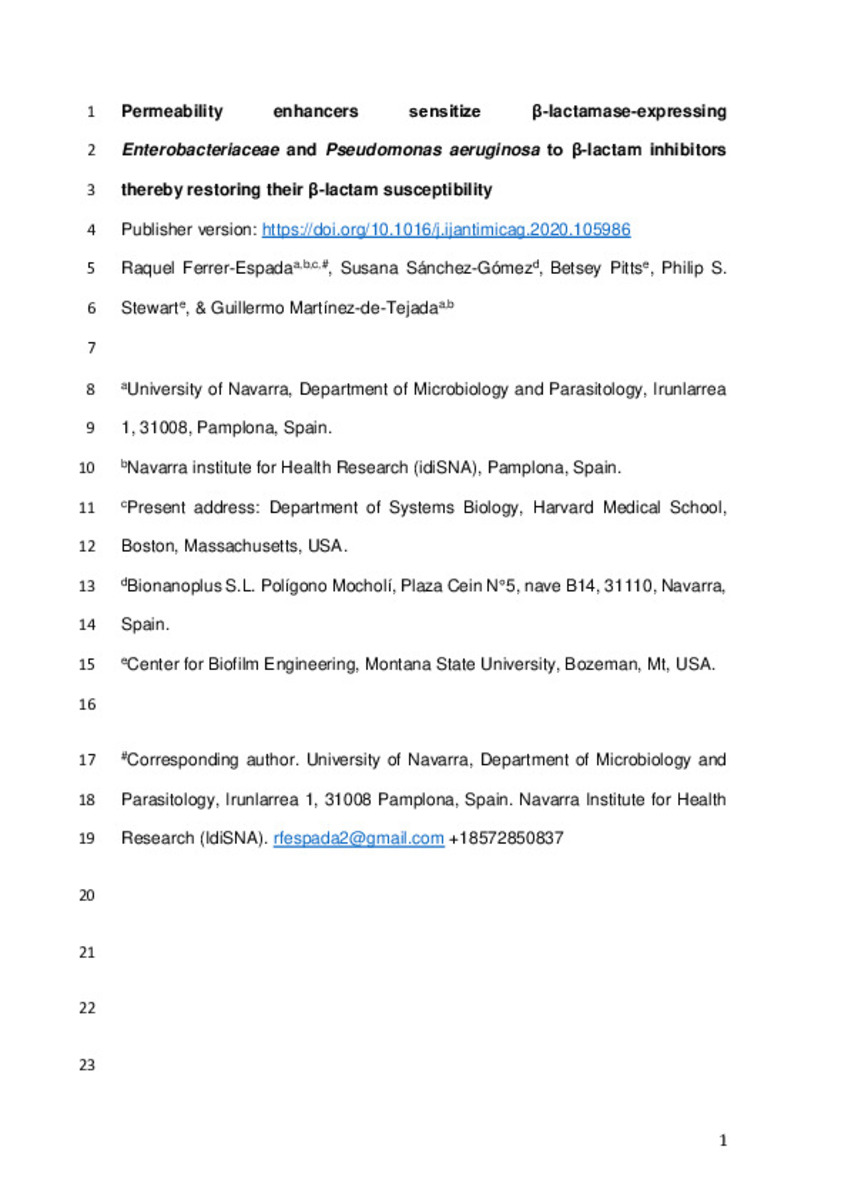Full metadata record
| DC Field | Value | Language |
|---|---|---|
| dc.creator | Ferrer-Espada, R. (Raquel) | - |
| dc.creator | Sánchez-Gómez, S. (Susana) | - |
| dc.creator | Pitts, B. (Betsey) | - |
| dc.creator | Stewart, P.S. (Philip S.) | - |
| dc.creator | Martinez-de-Tejada, G. (Guillermo) | - |
| dc.date.accessioned | 2024-01-26T10:28:05Z | - |
| dc.date.available | 2024-01-26T10:28:05Z | - |
| dc.date.issued | 2020 | - |
| dc.identifier.citation | Ferrer-Espada, R. (Raquel); Sánchez-Gómez, S. (Susana); Pitts, B. (Betsey); et al. "Permeability enhancers sensitize β-lactamase-expressing Enterobacteriaceae and Pseudomonas aeruginosa to β-lactamase inhibitors, thereby restoring their β-lactam susceptibility". International Journal of Antimicrobial Agents. 56 (1), 2020, 105986 | es |
| dc.identifier.issn | 1872-7913 | - |
| dc.identifier.uri | https://hdl.handle.net/10171/68570 | - |
| dc.description.abstract | Objectives: β-lactamases are the major resistance determinant for β-lactam antibiotics in Gram-negative bacteria. Although there are β-lactamase inhibitors (BLIs) available, β-lactam-BLI combinations are increasingly being neutralised by diverse mechanisms of bacterial resistance. This study hypothesised that permeability-increasing antimicrobial peptides (AMPs) could lower the amount of BLIs necessary to sensitise bacteria to antibiotics that are β-lactamase substrates. Methods: To test this hypothesis, checkerboard assays were performed to measure the ability of several AMPs to synergise with piperacillin, ticarcillin, amoxicillin, ampicillin, and ceftazidime in the presence of either tazobactam, clavulanic acid, sulbactam, aztreonam, phenylboronic acid (PBA), or oxacillin. Assays were performed using planktonic and biofilm-forming cells of Pseudomonas aeruginosa, Escherichia coli and Klebsiella pneumoniae overexpressing β-lactamases. Results: Synergy between polymyxin B nonapeptide (PMBN) and tazobactam boosted piperacillin activity by a factor of 128 in Escherichia coli (from 256 to 2 mg/L, fractional inhibitory concentration index (FICI) ≤ 0.02) and by a factor of at least 64 in Klebsiella pneumoniae (from 1024 mg/L to 16 mg/L, FICI ≤ 0.05). Synergy between PMBN and PBA enhanced ceftazidime activity 133 times in Pseudomonas aeruginosa (from 16 mg/L to 0.12 mg/L, FICI ≤ 0.03). As a consequence, MICs of all the tested antibiotics were brought down to therapeutic range. In addition, the combinations also reduced several orders of magnitude the amount of inhibitor needed for antibiotic sensitisation. Ceftazidime/PBA/PMBN at 50 times the planktonic MIC caused a 10 million-fold reduction in the viability of mature biofilms. Conclusion: This study proved that AMPs can synergise with BLIs and that this phenomenon can be exploited to sensitise bacteria to antibiotics. | es_ES |
| dc.description.sponsorship | This work was supported by the Proyectos de Investigación Universidad de Navarra, Spain (PIUNA-P2011-17 and P2015- 14 to G. M. T.) and the Gobierno Vasco, Spain (BFI-2011-9 to R. F. E). | es_ES |
| dc.language.iso | eng | es_ES |
| dc.publisher | Elsevier | es_ES |
| dc.rights | info:eu-repo/semantics/openAccess | es_ES |
| dc.subject | Biofilm | es_ES |
| dc.subject | Escherichia coli | es_ES |
| dc.subject | Klebsiella pneumoniae | es_ES |
| dc.subject | Pseudomonas aeruginosa | es_ES |
| dc.subject | Synergy | es_ES |
| dc.subject | β-lactamase inhibitor | es_ES |
| dc.title | Permeability enhancers sensitize β-lactamase-expressing Enterobacteriaceae and Pseudomonas aeruginosa to β-lactamase inhibitors, thereby restoring their β-lactam susceptibility | es_ES |
| dc.type | info:eu-repo/semantics/article | es_ES |
| dc.identifier.doi | 10.1016/j.ijantimicag.2020.105986 | - |
| dadun.citation.number | 1 | es_ES |
| dadun.citation.publicationName | International Journal of Antimicrobial Agents | es_ES |
| dadun.citation.startingPage | 105986 | es_ES |
| dadun.citation.volume | 56 | es_ES |
| dc.identifier.pmid | 32335279 | - |
Files in This Item:
Statistics and impact
Items in Dadun are protected by copyright, with all rights reserved, unless otherwise indicated.






